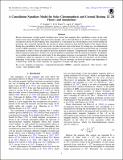Files in this item
A cancellation nanoflare model for solar chromospheric and coronal heating. II. 2D theory and simulations
Item metadata
| dc.contributor.author | Syntelis, P. | |
| dc.contributor.author | Priest, E. R. | |
| dc.contributor.author | Chitta, L. P. | |
| dc.date.accessioned | 2019-02-20T16:30:05Z | |
| dc.date.available | 2019-02-20T16:30:05Z | |
| dc.date.issued | 2019-02-07 | |
| dc.identifier | 257809762 | |
| dc.identifier | a03ae462-fbe1-40bf-82a1-119d342c8859 | |
| dc.identifier | 000458126700010 | |
| dc.identifier | 85062038592 | |
| dc.identifier | 000458126700010 | |
| dc.identifier.citation | Syntelis , P , Priest , E R & Chitta , L P 2019 , ' A cancellation nanoflare model for solar chromospheric and coronal heating. II. 2D theory and simulations ' , Astrophysical Journal , vol. 872 , no. 1 , 32 . https://doi.org/10.3847/1538-4357/aafaf8 | en |
| dc.identifier.issn | 0004-637X | |
| dc.identifier.other | ORCID: /0000-0003-3621-6690/work/74117759 | |
| dc.identifier.other | ORCID: /0000-0002-6377-0243/work/77131790 | |
| dc.identifier.uri | https://hdl.handle.net/10023/17105 | |
| dc.description | L.P.C. received funding from the European Union's Horizon 2020 research and innovation programme under the Marie Skłodowska-Curie grant agreement No. 707837 | en |
| dc.description.abstract | Recent observations at high spatial resolution have shown that magnetic flux cancellation occurs on the solar surface much more frequently than previously thought, and so this led Priest et al. (2018) to propose magnetic reconnection driven by photospheric flux cancellation as a mechanism for chromospheric and coronal heating. In particular, they estimated analytically the amount of energy released as heat and the height of the energy release during flux cancellation. In the present work, we take the next step in the theory by setting up a two-dimensional resistive MHD simulation of two canceling polarities in the presence of a horizontal external field and a stratified atmosphere in order to check and improve upon the analytical estimates. Computational evaluation of the energy release during reconnection is found to be in good qualitative agreement with the analytical estimates. In addition, we go further and undertake an initial study of the atmospheric response to reconnection. We find that, during the cancellation, either hot ejections or cool ones or a combination of both hot and cool ejections can be formed, depending on the height of the reconnection location. The hot structures can have the density and temperature of coronal loops, while the cooler structures are suggestive of surges and large spicules. | |
| dc.format.extent | 15 | |
| dc.format.extent | 2280779 | |
| dc.language.iso | eng | |
| dc.relation.ispartof | Astrophysical Journal | en |
| dc.subject | Magnetic reconnection | en |
| dc.subject | Magnetohydrodynamics (MHD) | en |
| dc.subject | Methods: numerical | en |
| dc.subject | Sun: activity | en |
| dc.subject | Sun: corona | en |
| dc.subject | Sun: magnetic fields | en |
| dc.subject | QB Astronomy | en |
| dc.subject | T-NDAS | en |
| dc.subject.lcc | QB | en |
| dc.title | A cancellation nanoflare model for solar chromospheric and coronal heating. II. 2D theory and simulations | en |
| dc.type | Journal article | en |
| dc.contributor.institution | University of St Andrews. Applied Mathematics | en |
| dc.identifier.doi | https://doi.org/10.3847/1538-4357/aafaf8 | |
| dc.description.status | Peer reviewed | en |
| dc.identifier.url | https://arxiv.org/abs/1901.02798 | en |
This item appears in the following Collection(s)
Items in the St Andrews Research Repository are protected by copyright, with all rights reserved, unless otherwise indicated.

